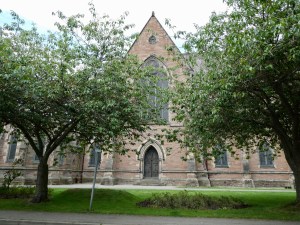I was up at the God awful time of 6:00 a.m. for my two hour bus trip to Inverness. The bus left right on the dot at 7:30 a.m. and took us north to Inverness past Loch Ness and Urquart Castle. I will be visiting those sites on Monday.
Anyway, by 9:35 we were pulling into the Inverness bus station. The driver from Ness Walk hotel was there to pick me up and shortly after 10:00 I was in my room and considering my options for the day. I ended up downloading an Inverness guided walking tour. The starting point, Inverness Cathedral, was only a couple blocks away so I pulled on my walking shoes and set out.

Now the River Ness, which feeds Loch Ness, splits the city of Inverness and the walk I chose required me to follow the river, which is literally out the front door of the hotel. (River Ness travels 7 miles from Loch Ness before it empties into the Atlantic). Anyway, I immediately I flipped on the guide and walked to the Inverness Cathedral. As I walked, learned that the various clan rivalries through the centuries destroyed much of the original architecture of Inverness so most of the buildings are relatively “new” as in only two or three hundred years old.

After the cathedral, I continued to follow the river as the guide provided me with a little bit of history of Inverness, including the history of Nessie, the Loch Ness monster. Apparently, the first recorded sighting of Nessie was in the mid 600s in the River Ness. Centuries passed before there was another recorded Nessie sighting, which was reported in Loch Ness in the 1930s. Now no offense to the Scots, but this whole Nessie thing sounds to me like someone was looking for a way to market Inverness, but that’s just cynical me.

Anyway, speaking of the River Ness, there are a number of suspension foot bridges that cross the River Ness in Inverness. There is one near my hotel, but the longest of these foot bridges is near the middle of Inverness and is known as the “Shoogly bridge”. Shoogly is a Scot word that means to sway, wobble or rock from side to side and after walking the length of the Shoogly bridge, I can safely say it is aptly named.


Once I crossed the Shoogly bridge, I took an alley to the old High Church, which was completed in 1772 replacing a far older church. There has apparently been a church on this site as far back as the 1100s. Now the interesting part of the High Church was the graveyard, which the redcoat government soldiers used as an execution ground for Jacobite prisoners. There are a series of stones in a direct line which mark where the prisoner would stand (or sit) and where the executioner would line up his musket and fire. The Brits sure love their execution stories.



Anyway, once I exited the graveyard, I was on Church Street, the oldest street in Invernesss. There were a couple highlights on this street. First up was the Dunbar’s Hospital where the poor could seek help. And just down the street there was the Abertarff House, a residence dating to 1693 and the oldest building in Inverness. I also passed the old Victorian Market, which was destroyed by fire in 1889.


At the end of Church Street I came face to face with the Inverness Town House dating to 1882. A recent renovation cleaned all the soot and dirt off the building to reveal its original splendor. And beside the building was a market cross dating to the 16th century with a unicorn adorning the top of the cross.

I then walked up the hill towards the Inverness Castle, but it is undergoing significant renovations so no entry was permitted. However, I strongly doubt I missed anything because the castle was only built in the 1820s and never served a fortification role. Instead, the “castle” was used as a prison, a police station and a courthouse.

At this point, I ended up back on the walking path by the Ness River and began walking in the direction of my hotel. Along the route, I passed the statutes of Faith Hope and Charity, aka the Three Graces, which had been moved from a building in another part of the city. And when they erected the three statutes on the new site, they screwed up the order of the statutes with Charity on the left, Faith in the middle and Hope On the right. Classic.

A little further down the river path, I came across a large red sandstone war memorial dedicated to a nurse named Edith Cabal who treated Allied and German soldiers in World War I. When she helped well over one hundred prisoners escape, the Germans arrested her and ultimately executed her. While she had no ties to Inverness, her heroism is legendary and deeply respected in these parts.


I continued along the river path eventually crossing a small suspension bridge, which took me to a little island in the middle of the river. The path continued along the small island until it intersected with another small suspension bridge which took me to the other side of the river. Fifteen minutes later and I was back where I started. It was a perfect walk. Tomorrow I am taking a tour of the Isle of Skye, which means a long day so it’ll be an early night.
